Energy Audits in the Food Industry: Beer Manufacturing in the UK
VerifiedAdded on 2021/04/21
|11
|2431
|19
Report
AI Summary
This report provides a comprehensive analysis of energy consumption within a beer manufacturing process, specifically focusing on a case study in the United Kingdom. It begins with an executive summary and an overview of the company, detailing its operations and the significance of energy usage within its processes. The report then delves into significant energy-consuming processes, highlighting the utilization of thermal and electrical energy, and includes charts illustrating energy consumption patterns. The energy flow of the company is examined, detailing the brewing process and its impact on energy use. Furthermore, the report explores the potential of renewable energy sources, such as solar and wind power, to improve energy efficiency and reduce costs. The report concludes with a summary of findings and recommendations for energy management within the brewery.
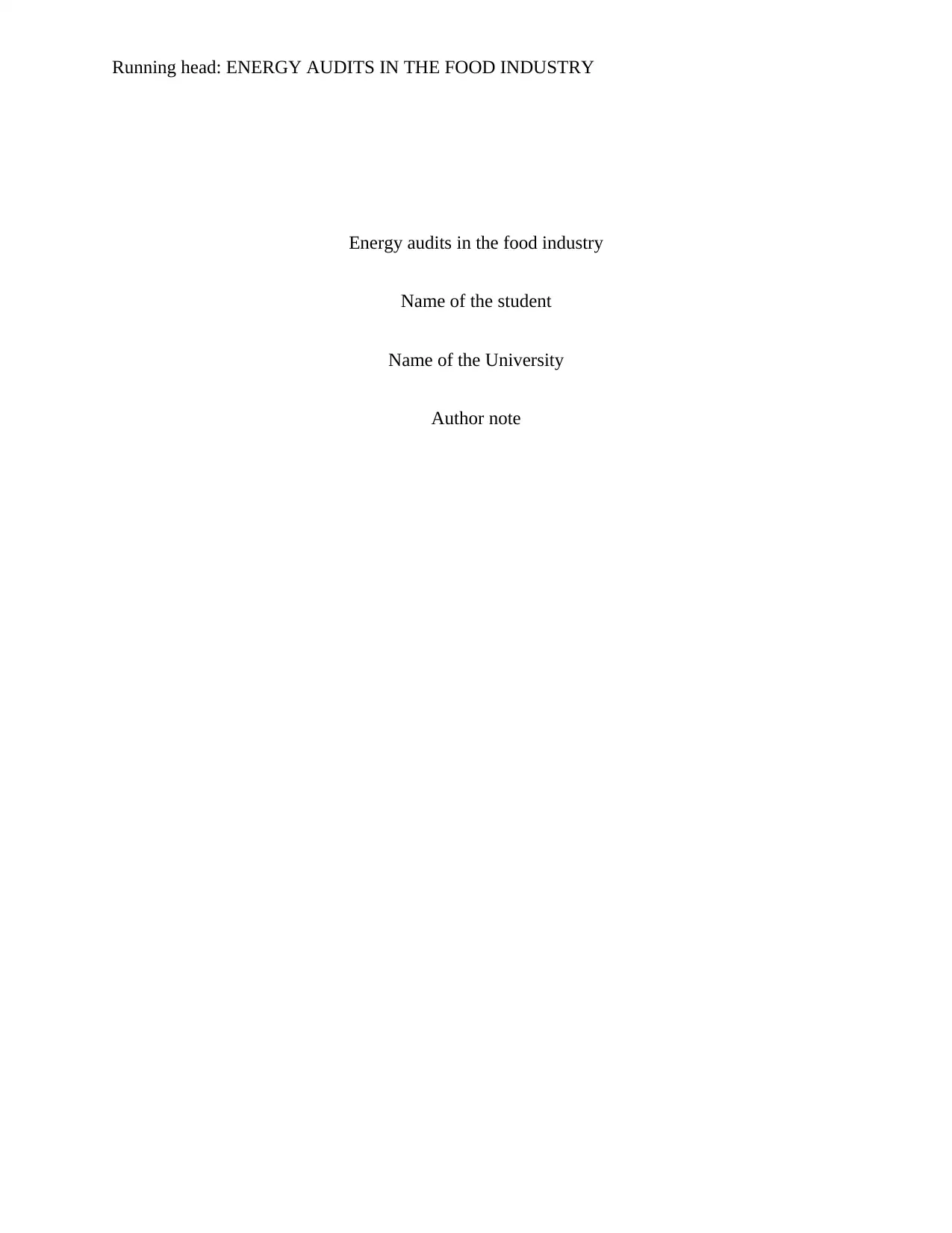
Running head: ENERGY AUDITS IN THE FOOD INDUSTRY
Energy audits in the food industry
Name of the student
Name of the University
Author note
Energy audits in the food industry
Name of the student
Name of the University
Author note
Paraphrase This Document
Need a fresh take? Get an instant paraphrase of this document with our AI Paraphraser

1ENERGY AUDITS IN THE FOOD INDUSTRY
Executive summary
This report discusses about the energy consumption in case of a beer manufacturing process. The
chosen country is United Kingdom. This report includes a discussion of the energy utilization
process which is involved in a beer factory. In addition, this report also discusses about the
energy flow of the company which shows the various processes involved and the associated
energy consumption. Lastly, this report includes a discussion of the associated renewable energy
consumption that can be adopted in the company processes.
Executive summary
This report discusses about the energy consumption in case of a beer manufacturing process. The
chosen country is United Kingdom. This report includes a discussion of the energy utilization
process which is involved in a beer factory. In addition, this report also discusses about the
energy flow of the company which shows the various processes involved and the associated
energy consumption. Lastly, this report includes a discussion of the associated renewable energy
consumption that can be adopted in the company processes.

2ENERGY AUDITS IN THE FOOD INDUSTRY
Table of Contents
Introduction......................................................................................................................................3
Discussion........................................................................................................................................3
Company overview......................................................................................................................3
Significant energy using processes..............................................................................................4
Energy flow of the company........................................................................................................5
Renewable energy........................................................................................................................7
Conclusion.......................................................................................................................................8
References........................................................................................................................................9
Table of Contents
Introduction......................................................................................................................................3
Discussion........................................................................................................................................3
Company overview......................................................................................................................3
Significant energy using processes..............................................................................................4
Energy flow of the company........................................................................................................5
Renewable energy........................................................................................................................7
Conclusion.......................................................................................................................................8
References........................................................................................................................................9
⊘ This is a preview!⊘
Do you want full access?
Subscribe today to unlock all pages.

Trusted by 1+ million students worldwide
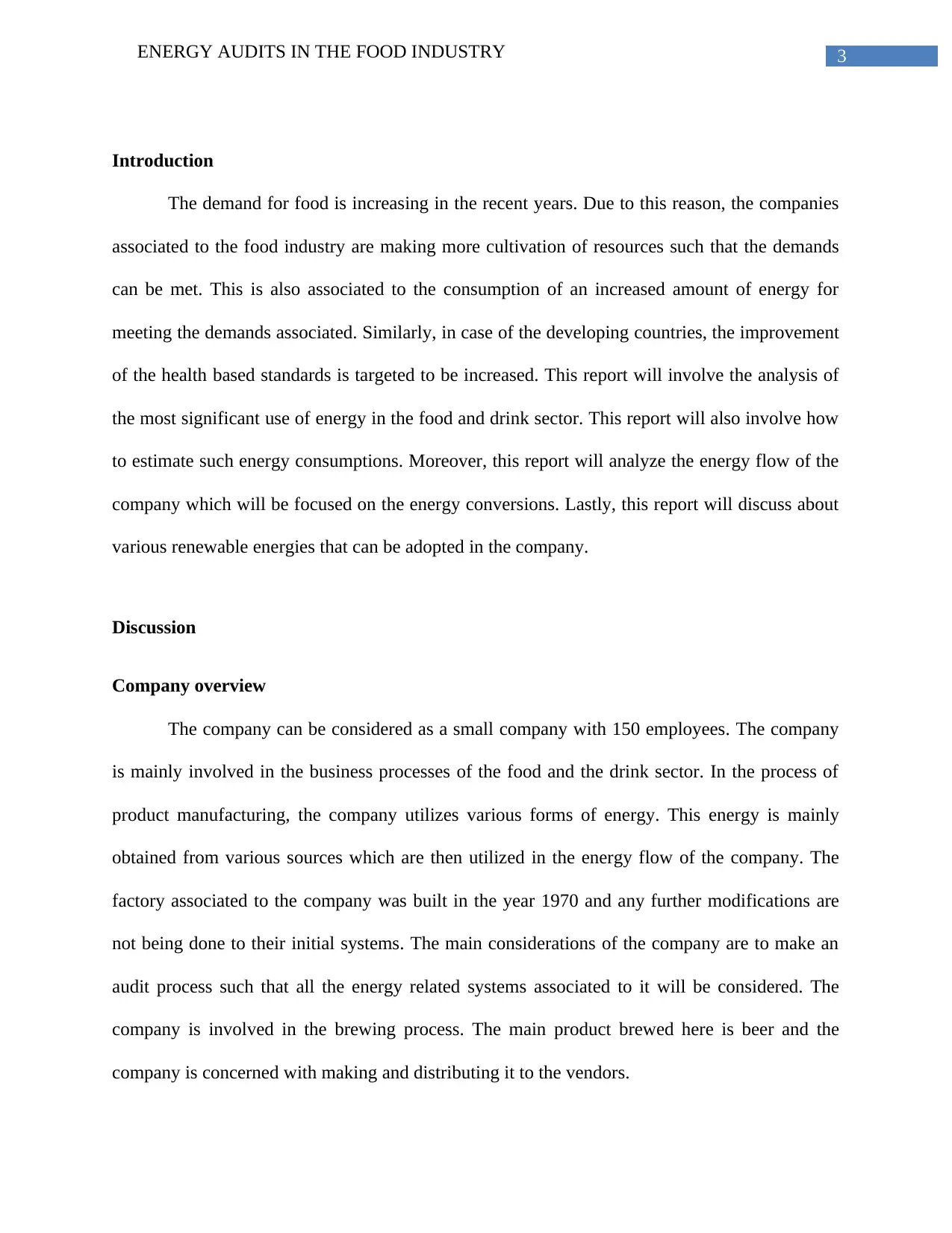
3ENERGY AUDITS IN THE FOOD INDUSTRY
Introduction
The demand for food is increasing in the recent years. Due to this reason, the companies
associated to the food industry are making more cultivation of resources such that the demands
can be met. This is also associated to the consumption of an increased amount of energy for
meeting the demands associated. Similarly, in case of the developing countries, the improvement
of the health based standards is targeted to be increased. This report will involve the analysis of
the most significant use of energy in the food and drink sector. This report will also involve how
to estimate such energy consumptions. Moreover, this report will analyze the energy flow of the
company which will be focused on the energy conversions. Lastly, this report will discuss about
various renewable energies that can be adopted in the company.
Discussion
Company overview
The company can be considered as a small company with 150 employees. The company
is mainly involved in the business processes of the food and the drink sector. In the process of
product manufacturing, the company utilizes various forms of energy. This energy is mainly
obtained from various sources which are then utilized in the energy flow of the company. The
factory associated to the company was built in the year 1970 and any further modifications are
not being done to their initial systems. The main considerations of the company are to make an
audit process such that all the energy related systems associated to it will be considered. The
company is involved in the brewing process. The main product brewed here is beer and the
company is concerned with making and distributing it to the vendors.
Introduction
The demand for food is increasing in the recent years. Due to this reason, the companies
associated to the food industry are making more cultivation of resources such that the demands
can be met. This is also associated to the consumption of an increased amount of energy for
meeting the demands associated. Similarly, in case of the developing countries, the improvement
of the health based standards is targeted to be increased. This report will involve the analysis of
the most significant use of energy in the food and drink sector. This report will also involve how
to estimate such energy consumptions. Moreover, this report will analyze the energy flow of the
company which will be focused on the energy conversions. Lastly, this report will discuss about
various renewable energies that can be adopted in the company.
Discussion
Company overview
The company can be considered as a small company with 150 employees. The company
is mainly involved in the business processes of the food and the drink sector. In the process of
product manufacturing, the company utilizes various forms of energy. This energy is mainly
obtained from various sources which are then utilized in the energy flow of the company. The
factory associated to the company was built in the year 1970 and any further modifications are
not being done to their initial systems. The main considerations of the company are to make an
audit process such that all the energy related systems associated to it will be considered. The
company is involved in the brewing process. The main product brewed here is beer and the
company is concerned with making and distributing it to the vendors.
Paraphrase This Document
Need a fresh take? Get an instant paraphrase of this document with our AI Paraphraser
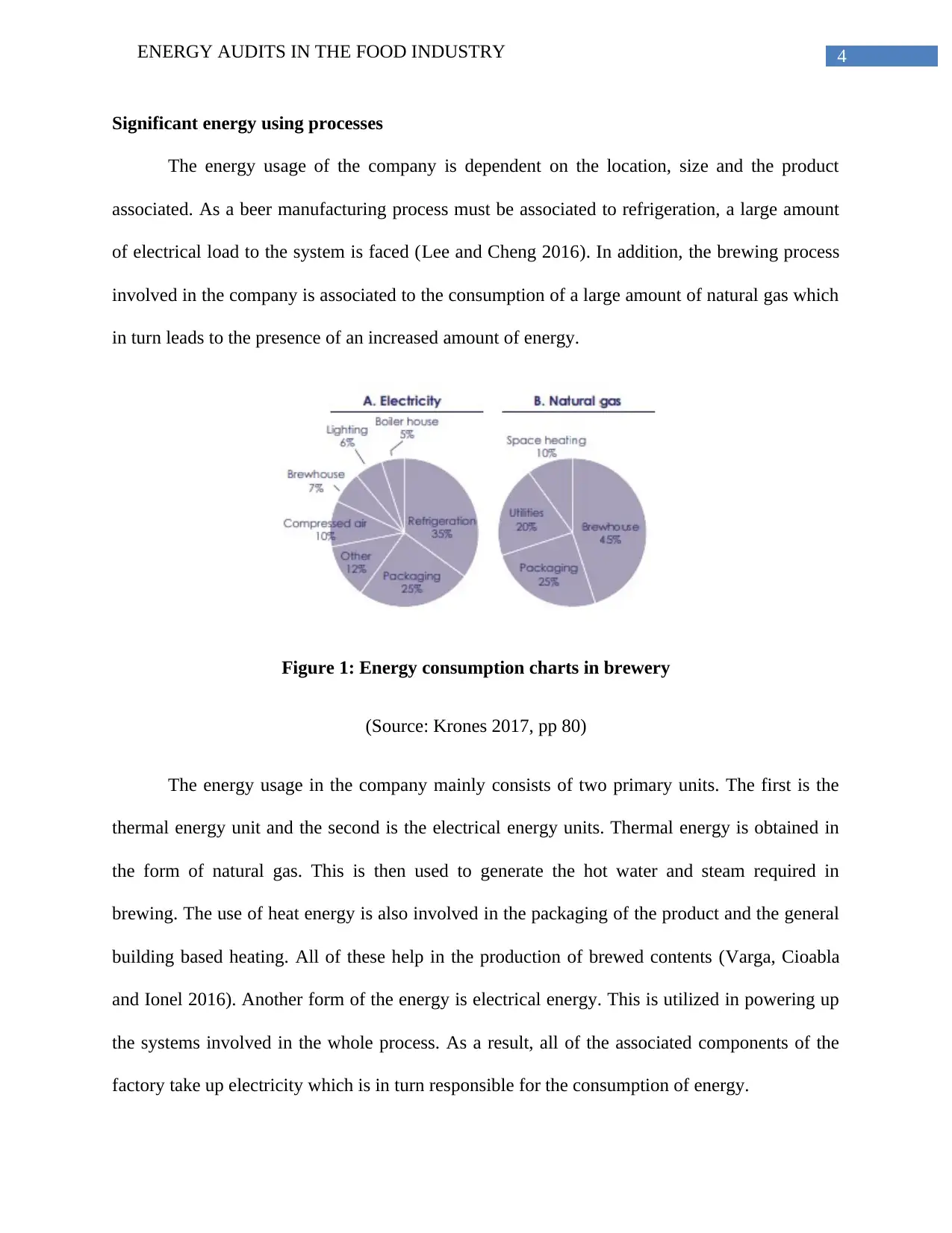
4ENERGY AUDITS IN THE FOOD INDUSTRY
Significant energy using processes
The energy usage of the company is dependent on the location, size and the product
associated. As a beer manufacturing process must be associated to refrigeration, a large amount
of electrical load to the system is faced (Lee and Cheng 2016). In addition, the brewing process
involved in the company is associated to the consumption of a large amount of natural gas which
in turn leads to the presence of an increased amount of energy.
Figure 1: Energy consumption charts in brewery
(Source: Krones 2017, pp 80)
The energy usage in the company mainly consists of two primary units. The first is the
thermal energy unit and the second is the electrical energy units. Thermal energy is obtained in
the form of natural gas. This is then used to generate the hot water and steam required in
brewing. The use of heat energy is also involved in the packaging of the product and the general
building based heating. All of these help in the production of brewed contents (Varga, Cioabla
and Ionel 2016). Another form of the energy is electrical energy. This is utilized in powering up
the systems involved in the whole process. As a result, all of the associated components of the
factory take up electricity which is in turn responsible for the consumption of energy.
Significant energy using processes
The energy usage of the company is dependent on the location, size and the product
associated. As a beer manufacturing process must be associated to refrigeration, a large amount
of electrical load to the system is faced (Lee and Cheng 2016). In addition, the brewing process
involved in the company is associated to the consumption of a large amount of natural gas which
in turn leads to the presence of an increased amount of energy.
Figure 1: Energy consumption charts in brewery
(Source: Krones 2017, pp 80)
The energy usage in the company mainly consists of two primary units. The first is the
thermal energy unit and the second is the electrical energy units. Thermal energy is obtained in
the form of natural gas. This is then used to generate the hot water and steam required in
brewing. The use of heat energy is also involved in the packaging of the product and the general
building based heating. All of these help in the production of brewed contents (Varga, Cioabla
and Ionel 2016). Another form of the energy is electrical energy. This is utilized in powering up
the systems involved in the whole process. As a result, all of the associated components of the
factory take up electricity which is in turn responsible for the consumption of energy.

5ENERGY AUDITS IN THE FOOD INDUSTRY
According to the provided chart, there are five different sinks of electricity which takes
up a lot of power for operations. 5% of the total energy consumption is done from the boiler
house. In addition, lighting requirements of the factory involved tales up 6% of the total energy
related to the others. Furthermore, the brew-house takes 7% of the energy allocated for
processing while the use of compressed air takes in 10% of power (Morosini et al. 2016). The
major sinks in this system are the refrigeration part and the packaging part. The refrigeration part
is utilized in taking 35% of input while the packaging part of the factory takes up 25% of the
total energy.
Moreover, on contrary to the use of electricity, natural gas is also used in this process.
This accounts for the use of thermal energy in the system. For heating of the involved space,
10% of natural gas is used. The utilities involved in the process which must be heated takes up
20% of the natural gas consumption in the system (Dubrovskis and Plume 2016). In addition to
this, packaging of the product utilizes 25% of the natural gas consumption. Lastly, the brew-
house consumes 45% of the total natural gas consumptions.
Energy flow of the company
The utilization of thermal energy involves 70% of the total energy consumed in the
brewery. In the brewery, the brewing process is involved. This results in the formation of pre-
processed beer. Although this consumption is accountable for 30% of the energy cost, it can be
considered as a very high requirement (CIOABLĂ et al. 2016). For this reason, the efforts for
reducing this consumption are being utilized. In addition, the reduction in the use of the electrical
energy in the whole process is also being adopted.
According to the provided chart, there are five different sinks of electricity which takes
up a lot of power for operations. 5% of the total energy consumption is done from the boiler
house. In addition, lighting requirements of the factory involved tales up 6% of the total energy
related to the others. Furthermore, the brew-house takes 7% of the energy allocated for
processing while the use of compressed air takes in 10% of power (Morosini et al. 2016). The
major sinks in this system are the refrigeration part and the packaging part. The refrigeration part
is utilized in taking 35% of input while the packaging part of the factory takes up 25% of the
total energy.
Moreover, on contrary to the use of electricity, natural gas is also used in this process.
This accounts for the use of thermal energy in the system. For heating of the involved space,
10% of natural gas is used. The utilities involved in the process which must be heated takes up
20% of the natural gas consumption in the system (Dubrovskis and Plume 2016). In addition to
this, packaging of the product utilizes 25% of the natural gas consumption. Lastly, the brew-
house consumes 45% of the total natural gas consumptions.
Energy flow of the company
The utilization of thermal energy involves 70% of the total energy consumed in the
brewery. In the brewery, the brewing process is involved. This results in the formation of pre-
processed beer. Although this consumption is accountable for 30% of the energy cost, it can be
considered as a very high requirement (CIOABLĂ et al. 2016). For this reason, the efforts for
reducing this consumption are being utilized. In addition, the reduction in the use of the electrical
energy in the whole process is also being adopted.
⊘ This is a preview!⊘
Do you want full access?
Subscribe today to unlock all pages.

Trusted by 1+ million students worldwide
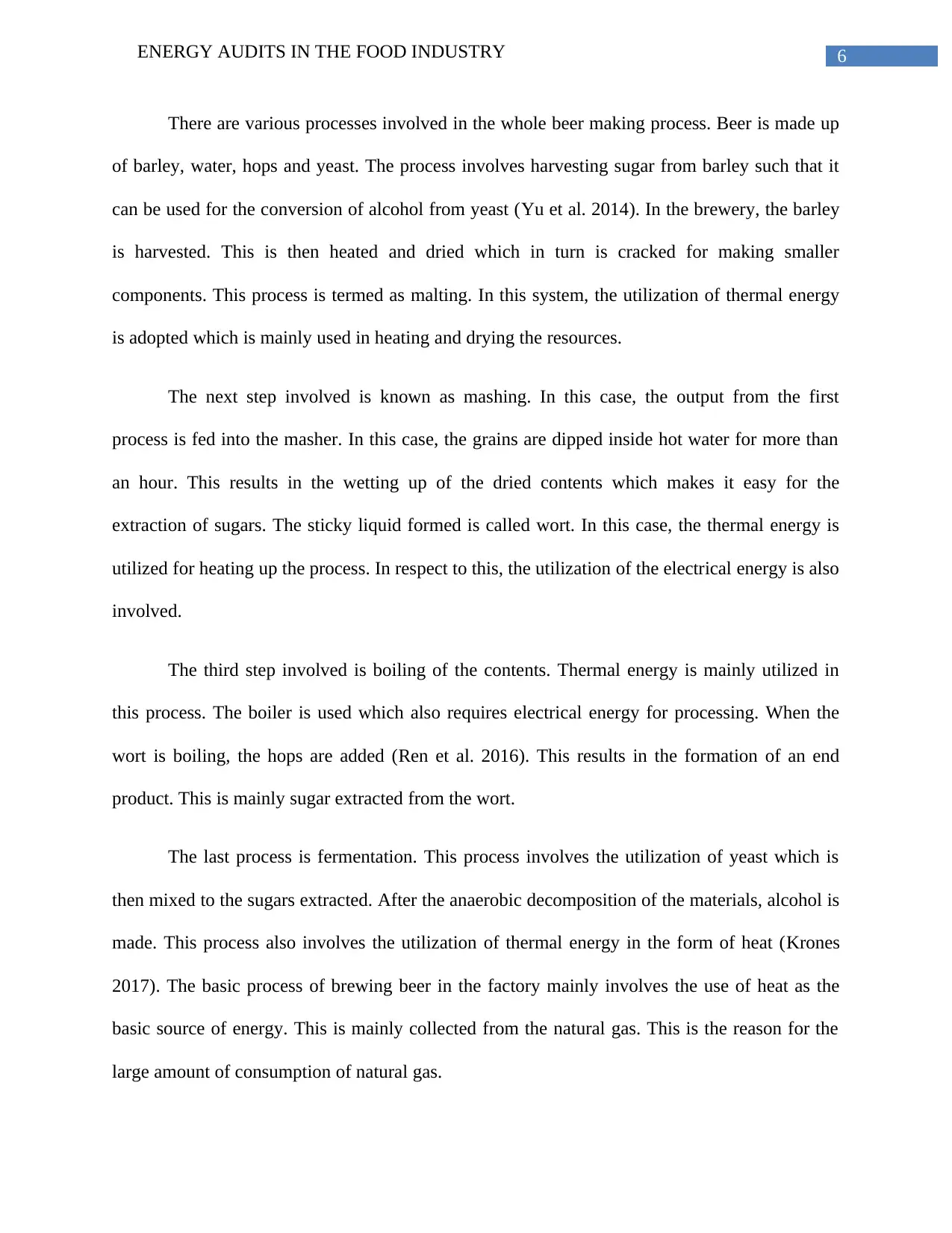
6ENERGY AUDITS IN THE FOOD INDUSTRY
There are various processes involved in the whole beer making process. Beer is made up
of barley, water, hops and yeast. The process involves harvesting sugar from barley such that it
can be used for the conversion of alcohol from yeast (Yu et al. 2014). In the brewery, the barley
is harvested. This is then heated and dried which in turn is cracked for making smaller
components. This process is termed as malting. In this system, the utilization of thermal energy
is adopted which is mainly used in heating and drying the resources.
The next step involved is known as mashing. In this case, the output from the first
process is fed into the masher. In this case, the grains are dipped inside hot water for more than
an hour. This results in the wetting up of the dried contents which makes it easy for the
extraction of sugars. The sticky liquid formed is called wort. In this case, the thermal energy is
utilized for heating up the process. In respect to this, the utilization of the electrical energy is also
involved.
The third step involved is boiling of the contents. Thermal energy is mainly utilized in
this process. The boiler is used which also requires electrical energy for processing. When the
wort is boiling, the hops are added (Ren et al. 2016). This results in the formation of an end
product. This is mainly sugar extracted from the wort.
The last process is fermentation. This process involves the utilization of yeast which is
then mixed to the sugars extracted. After the anaerobic decomposition of the materials, alcohol is
made. This process also involves the utilization of thermal energy in the form of heat (Krones
2017). The basic process of brewing beer in the factory mainly involves the use of heat as the
basic source of energy. This is mainly collected from the natural gas. This is the reason for the
large amount of consumption of natural gas.
There are various processes involved in the whole beer making process. Beer is made up
of barley, water, hops and yeast. The process involves harvesting sugar from barley such that it
can be used for the conversion of alcohol from yeast (Yu et al. 2014). In the brewery, the barley
is harvested. This is then heated and dried which in turn is cracked for making smaller
components. This process is termed as malting. In this system, the utilization of thermal energy
is adopted which is mainly used in heating and drying the resources.
The next step involved is known as mashing. In this case, the output from the first
process is fed into the masher. In this case, the grains are dipped inside hot water for more than
an hour. This results in the wetting up of the dried contents which makes it easy for the
extraction of sugars. The sticky liquid formed is called wort. In this case, the thermal energy is
utilized for heating up the process. In respect to this, the utilization of the electrical energy is also
involved.
The third step involved is boiling of the contents. Thermal energy is mainly utilized in
this process. The boiler is used which also requires electrical energy for processing. When the
wort is boiling, the hops are added (Ren et al. 2016). This results in the formation of an end
product. This is mainly sugar extracted from the wort.
The last process is fermentation. This process involves the utilization of yeast which is
then mixed to the sugars extracted. After the anaerobic decomposition of the materials, alcohol is
made. This process also involves the utilization of thermal energy in the form of heat (Krones
2017). The basic process of brewing beer in the factory mainly involves the use of heat as the
basic source of energy. This is mainly collected from the natural gas. This is the reason for the
large amount of consumption of natural gas.
Paraphrase This Document
Need a fresh take? Get an instant paraphrase of this document with our AI Paraphraser
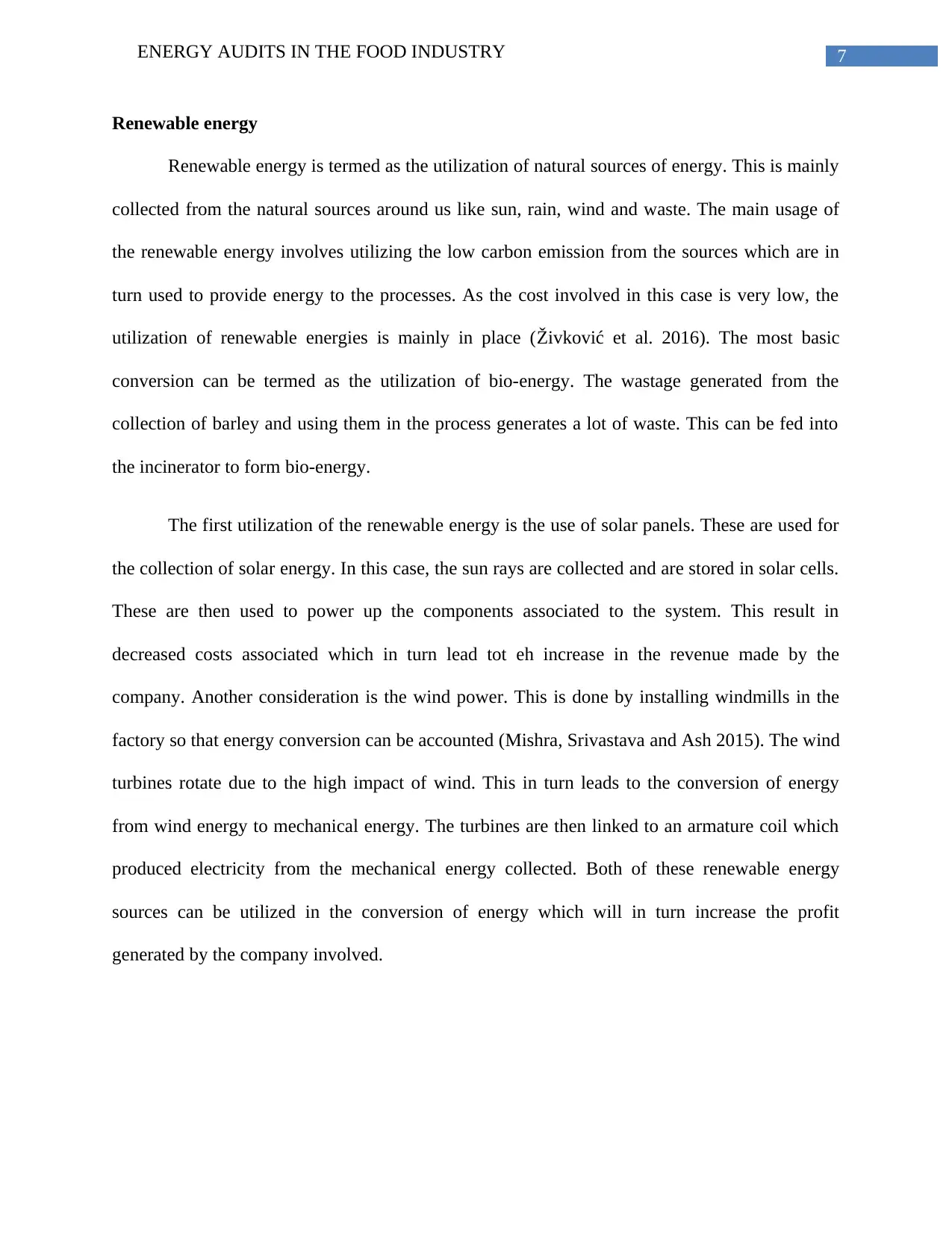
7ENERGY AUDITS IN THE FOOD INDUSTRY
Renewable energy
Renewable energy is termed as the utilization of natural sources of energy. This is mainly
collected from the natural sources around us like sun, rain, wind and waste. The main usage of
the renewable energy involves utilizing the low carbon emission from the sources which are in
turn used to provide energy to the processes. As the cost involved in this case is very low, the
utilization of renewable energies is mainly in place (Živković et al. 2016). The most basic
conversion can be termed as the utilization of bio-energy. The wastage generated from the
collection of barley and using them in the process generates a lot of waste. This can be fed into
the incinerator to form bio-energy.
The first utilization of the renewable energy is the use of solar panels. These are used for
the collection of solar energy. In this case, the sun rays are collected and are stored in solar cells.
These are then used to power up the components associated to the system. This result in
decreased costs associated which in turn lead tot eh increase in the revenue made by the
company. Another consideration is the wind power. This is done by installing windmills in the
factory so that energy conversion can be accounted (Mishra, Srivastava and Ash 2015). The wind
turbines rotate due to the high impact of wind. This in turn leads to the conversion of energy
from wind energy to mechanical energy. The turbines are then linked to an armature coil which
produced electricity from the mechanical energy collected. Both of these renewable energy
sources can be utilized in the conversion of energy which will in turn increase the profit
generated by the company involved.
Renewable energy
Renewable energy is termed as the utilization of natural sources of energy. This is mainly
collected from the natural sources around us like sun, rain, wind and waste. The main usage of
the renewable energy involves utilizing the low carbon emission from the sources which are in
turn used to provide energy to the processes. As the cost involved in this case is very low, the
utilization of renewable energies is mainly in place (Živković et al. 2016). The most basic
conversion can be termed as the utilization of bio-energy. The wastage generated from the
collection of barley and using them in the process generates a lot of waste. This can be fed into
the incinerator to form bio-energy.
The first utilization of the renewable energy is the use of solar panels. These are used for
the collection of solar energy. In this case, the sun rays are collected and are stored in solar cells.
These are then used to power up the components associated to the system. This result in
decreased costs associated which in turn lead tot eh increase in the revenue made by the
company. Another consideration is the wind power. This is done by installing windmills in the
factory so that energy conversion can be accounted (Mishra, Srivastava and Ash 2015). The wind
turbines rotate due to the high impact of wind. This in turn leads to the conversion of energy
from wind energy to mechanical energy. The turbines are then linked to an armature coil which
produced electricity from the mechanical energy collected. Both of these renewable energy
sources can be utilized in the conversion of energy which will in turn increase the profit
generated by the company involved.
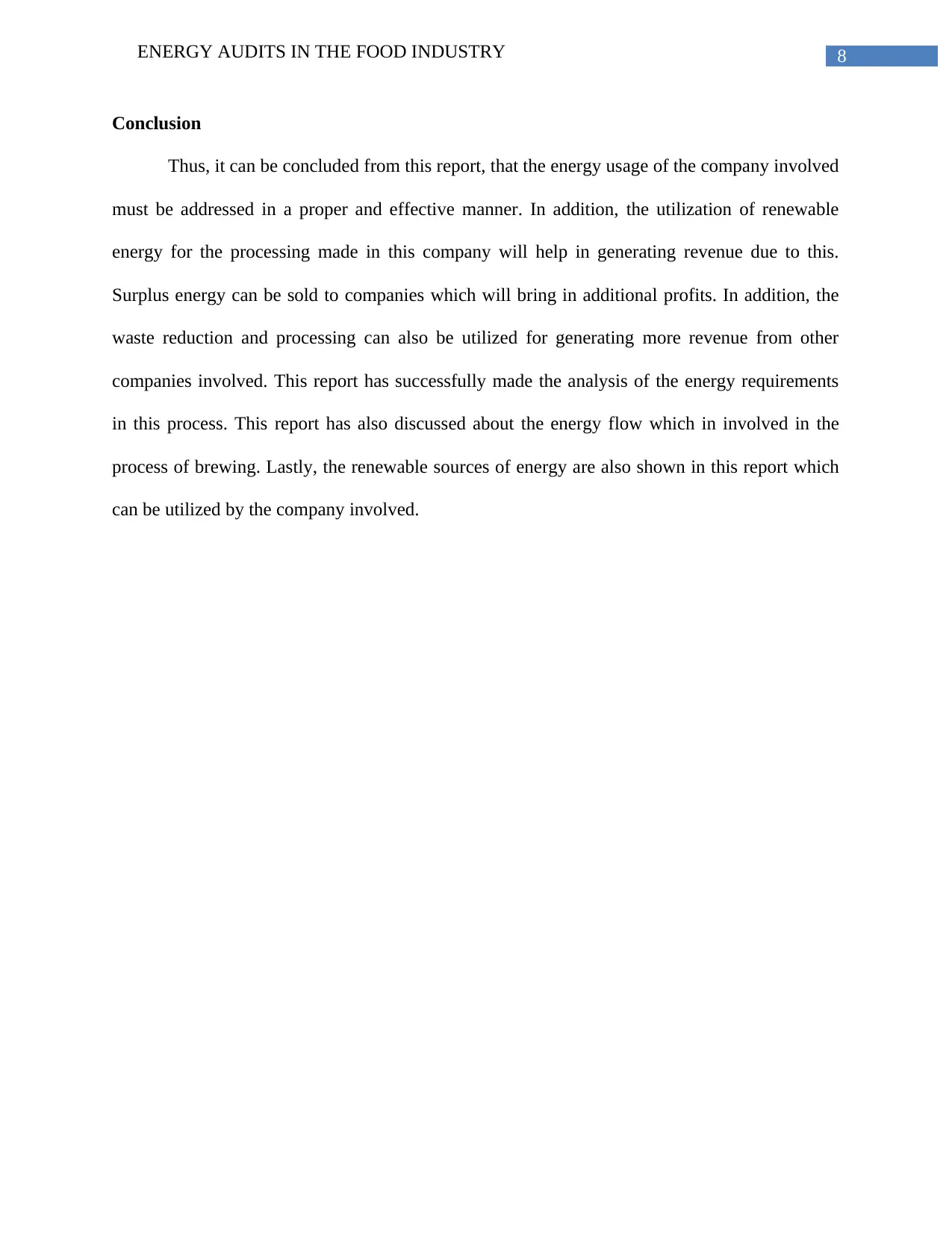
8ENERGY AUDITS IN THE FOOD INDUSTRY
Conclusion
Thus, it can be concluded from this report, that the energy usage of the company involved
must be addressed in a proper and effective manner. In addition, the utilization of renewable
energy for the processing made in this company will help in generating revenue due to this.
Surplus energy can be sold to companies which will bring in additional profits. In addition, the
waste reduction and processing can also be utilized for generating more revenue from other
companies involved. This report has successfully made the analysis of the energy requirements
in this process. This report has also discussed about the energy flow which in involved in the
process of brewing. Lastly, the renewable sources of energy are also shown in this report which
can be utilized by the company involved.
Conclusion
Thus, it can be concluded from this report, that the energy usage of the company involved
must be addressed in a proper and effective manner. In addition, the utilization of renewable
energy for the processing made in this company will help in generating revenue due to this.
Surplus energy can be sold to companies which will bring in additional profits. In addition, the
waste reduction and processing can also be utilized for generating more revenue from other
companies involved. This report has successfully made the analysis of the energy requirements
in this process. This report has also discussed about the energy flow which in involved in the
process of brewing. Lastly, the renewable sources of energy are also shown in this report which
can be utilized by the company involved.
⊘ This is a preview!⊘
Do you want full access?
Subscribe today to unlock all pages.

Trusted by 1+ million students worldwide
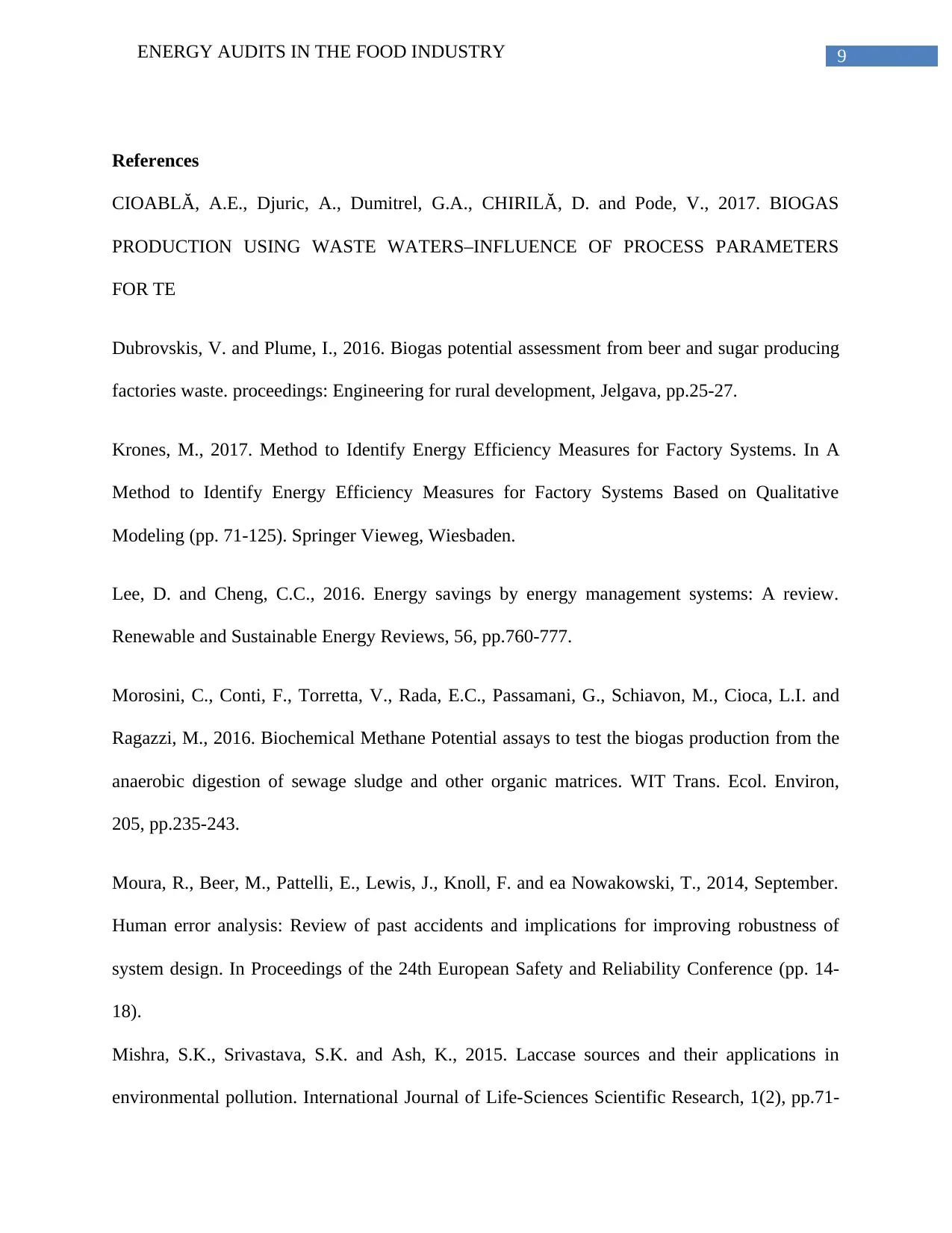
9ENERGY AUDITS IN THE FOOD INDUSTRY
References
CIOABLĂ, A.E., Djuric, A., Dumitrel, G.A., CHIRILĂ, D. and Pode, V., 2017. BIOGAS
PRODUCTION USING WASTE WATERS–INFLUENCE OF PROCESS PARAMETERS
FOR TE
Dubrovskis, V. and Plume, I., 2016. Biogas potential assessment from beer and sugar producing
factories waste. proceedings: Engineering for rural development, Jelgava, pp.25-27.
Krones, M., 2017. Method to Identify Energy Efficiency Measures for Factory Systems. In A
Method to Identify Energy Efficiency Measures for Factory Systems Based on Qualitative
Modeling (pp. 71-125). Springer Vieweg, Wiesbaden.
Lee, D. and Cheng, C.C., 2016. Energy savings by energy management systems: A review.
Renewable and Sustainable Energy Reviews, 56, pp.760-777.
Morosini, C., Conti, F., Torretta, V., Rada, E.C., Passamani, G., Schiavon, M., Cioca, L.I. and
Ragazzi, M., 2016. Biochemical Methane Potential assays to test the biogas production from the
anaerobic digestion of sewage sludge and other organic matrices. WIT Trans. Ecol. Environ,
205, pp.235-243.
Moura, R., Beer, M., Pattelli, E., Lewis, J., Knoll, F. and ea Nowakowski, T., 2014, September.
Human error analysis: Review of past accidents and implications for improving robustness of
system design. In Proceedings of the 24th European Safety and Reliability Conference (pp. 14-
18).
Mishra, S.K., Srivastava, S.K. and Ash, K., 2015. Laccase sources and their applications in
environmental pollution. International Journal of Life-Sciences Scientific Research, 1(2), pp.71-
References
CIOABLĂ, A.E., Djuric, A., Dumitrel, G.A., CHIRILĂ, D. and Pode, V., 2017. BIOGAS
PRODUCTION USING WASTE WATERS–INFLUENCE OF PROCESS PARAMETERS
FOR TE
Dubrovskis, V. and Plume, I., 2016. Biogas potential assessment from beer and sugar producing
factories waste. proceedings: Engineering for rural development, Jelgava, pp.25-27.
Krones, M., 2017. Method to Identify Energy Efficiency Measures for Factory Systems. In A
Method to Identify Energy Efficiency Measures for Factory Systems Based on Qualitative
Modeling (pp. 71-125). Springer Vieweg, Wiesbaden.
Lee, D. and Cheng, C.C., 2016. Energy savings by energy management systems: A review.
Renewable and Sustainable Energy Reviews, 56, pp.760-777.
Morosini, C., Conti, F., Torretta, V., Rada, E.C., Passamani, G., Schiavon, M., Cioca, L.I. and
Ragazzi, M., 2016. Biochemical Methane Potential assays to test the biogas production from the
anaerobic digestion of sewage sludge and other organic matrices. WIT Trans. Ecol. Environ,
205, pp.235-243.
Moura, R., Beer, M., Pattelli, E., Lewis, J., Knoll, F. and ea Nowakowski, T., 2014, September.
Human error analysis: Review of past accidents and implications for improving robustness of
system design. In Proceedings of the 24th European Safety and Reliability Conference (pp. 14-
18).
Mishra, S.K., Srivastava, S.K. and Ash, K., 2015. Laccase sources and their applications in
environmental pollution. International Journal of Life-Sciences Scientific Research, 1(2), pp.71-
Paraphrase This Document
Need a fresh take? Get an instant paraphrase of this document with our AI Paraphraser
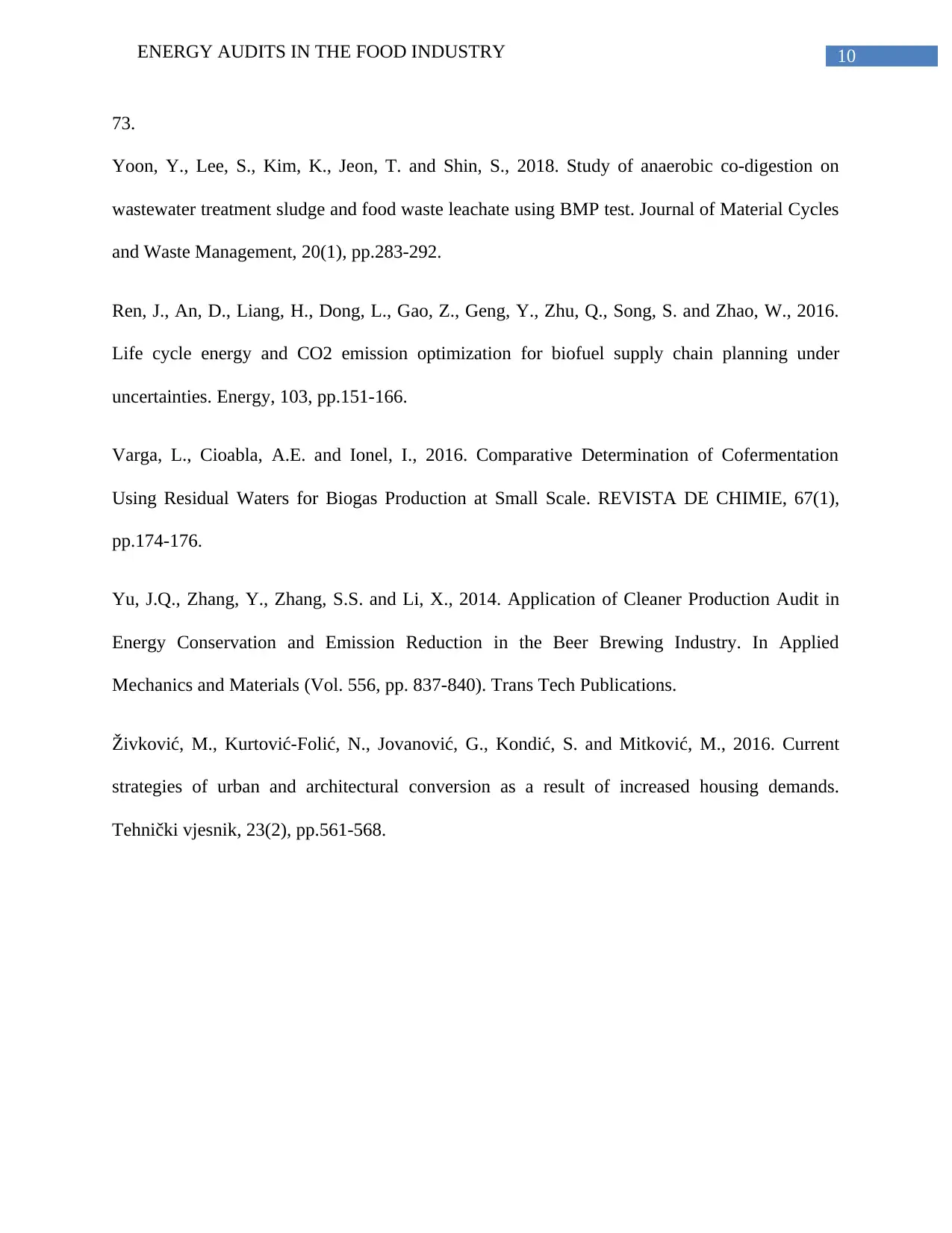
10ENERGY AUDITS IN THE FOOD INDUSTRY
73.
Yoon, Y., Lee, S., Kim, K., Jeon, T. and Shin, S., 2018. Study of anaerobic co-digestion on
wastewater treatment sludge and food waste leachate using BMP test. Journal of Material Cycles
and Waste Management, 20(1), pp.283-292.
Ren, J., An, D., Liang, H., Dong, L., Gao, Z., Geng, Y., Zhu, Q., Song, S. and Zhao, W., 2016.
Life cycle energy and CO2 emission optimization for biofuel supply chain planning under
uncertainties. Energy, 103, pp.151-166.
Varga, L., Cioabla, A.E. and Ionel, I., 2016. Comparative Determination of Cofermentation
Using Residual Waters for Biogas Production at Small Scale. REVISTA DE CHIMIE, 67(1),
pp.174-176.
Yu, J.Q., Zhang, Y., Zhang, S.S. and Li, X., 2014. Application of Cleaner Production Audit in
Energy Conservation and Emission Reduction in the Beer Brewing Industry. In Applied
Mechanics and Materials (Vol. 556, pp. 837-840). Trans Tech Publications.
Živković, M., Kurtović-Folić, N., Jovanović, G., Kondić, S. and Mitković, M., 2016. Current
strategies of urban and architectural conversion as a result of increased housing demands.
Tehnički vjesnik, 23(2), pp.561-568.
73.
Yoon, Y., Lee, S., Kim, K., Jeon, T. and Shin, S., 2018. Study of anaerobic co-digestion on
wastewater treatment sludge and food waste leachate using BMP test. Journal of Material Cycles
and Waste Management, 20(1), pp.283-292.
Ren, J., An, D., Liang, H., Dong, L., Gao, Z., Geng, Y., Zhu, Q., Song, S. and Zhao, W., 2016.
Life cycle energy and CO2 emission optimization for biofuel supply chain planning under
uncertainties. Energy, 103, pp.151-166.
Varga, L., Cioabla, A.E. and Ionel, I., 2016. Comparative Determination of Cofermentation
Using Residual Waters for Biogas Production at Small Scale. REVISTA DE CHIMIE, 67(1),
pp.174-176.
Yu, J.Q., Zhang, Y., Zhang, S.S. and Li, X., 2014. Application of Cleaner Production Audit in
Energy Conservation and Emission Reduction in the Beer Brewing Industry. In Applied
Mechanics and Materials (Vol. 556, pp. 837-840). Trans Tech Publications.
Živković, M., Kurtović-Folić, N., Jovanović, G., Kondić, S. and Mitković, M., 2016. Current
strategies of urban and architectural conversion as a result of increased housing demands.
Tehnički vjesnik, 23(2), pp.561-568.
1 out of 11
Related Documents
Your All-in-One AI-Powered Toolkit for Academic Success.
+13062052269
info@desklib.com
Available 24*7 on WhatsApp / Email
![[object Object]](/_next/static/media/star-bottom.7253800d.svg)
Unlock your academic potential
Copyright © 2020–2025 A2Z Services. All Rights Reserved. Developed and managed by ZUCOL.





